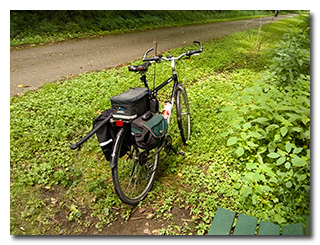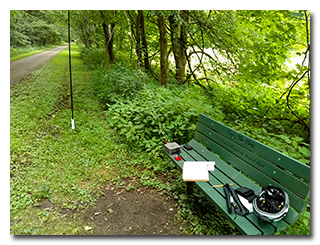
by William Eric McFadden
From the Wayne National Forest website:
-
The Wayne National Forest is a patchwork of public land that covers over a quarter million acres of Appalachian foothills of southeastern Ohio. The Forest is divided into three units managed out of two Ranger District offices located in Nelsonville and Ironton, with a field office in Marietta.
The Forest features over 300 miles of trails for hiking, all-terrain vehicle riding, mountain biking, or horseback riding in season. The trails are open to ATVs, mountain bikes, and horseback riders from mid-April to mid-December each year. Come visit the Wayne and hike or ride our trails!
Pictures
- Eric's loaded bicycle: 1 | 2
- Eric's station
Description
 On Saturday, July 10, 2021, one member of the Southeast Ohio Radio Adventure Team
performed a successful activation of Wayne National Forest (K-4521)
as part of the Parks on the Air (POTA; link) program.
Eric McFadden, WD8RIF, performed the impromptu bicycle-portable activation within the Wayne National Forest
on the Hockhocking-Adena Bikeway, adjacent to the Hocking River, as a "shake-down" bicycle trip and activation
prior to the upcoming Adventure Radio Society Flight of the Bumblebees operating event in which Eric planned to
bike to the same location with the same equipment.
On Saturday, July 10, 2021, one member of the Southeast Ohio Radio Adventure Team
performed a successful activation of Wayne National Forest (K-4521)
as part of the Parks on the Air (POTA; link) program.
Eric McFadden, WD8RIF, performed the impromptu bicycle-portable activation within the Wayne National Forest
on the Hockhocking-Adena Bikeway, adjacent to the Hocking River, as a "shake-down" bicycle trip and activation
prior to the upcoming Adventure Radio Society Flight of the Bumblebees operating event in which Eric planned to
bike to the same location with the same equipment.
For this activation, Eric drove with his bicycle atop his car to West State Street Park in Athens, Ohio, and bicycled approximately nine miles on the Hockhocking-Adena Bikeway to enter the Wayne National Forest at bikeway mile 12.5. Eric arrived at his intended destination about 1545 UTC and found the park bench there to be unoccupied, with nothing happening at the motorcycle racing-track across the river. Eric deployed his 28½' end-fed wire as an inverted-vee supported on his Goture Red Fox 7.2m carbon-fiber telescoping fishing pole and layed out three 17' radials as well as he could without running any of them on the bike path. Eric set up his Elecraft K1 on the bench and was on the air at 1605 UTC.
 As expected, Eric found he had good cell-signal at this location and he was able to spot himself on the POTA Spots website
and to use POTA Spots to identify possible Park-to-Park (P2P) QSOs.
As expected, Eric found he had good cell-signal at this location and he was able to spot himself on the POTA Spots website
and to use POTA Spots to identify possible Park-to-Park (P2P) QSOs.
Eric began operations on 40m and was a bit surprised to find that the K1's internal ATU could provide no better than a 2.5:1 match to the antenna with 4:1 balun on this band but decided to continue his activation. Eric also found that his K1 didn't produce clean code when he used his single-lever paddle as a cootie key—some of the dashes seemed to run together for some reason—so Eric reconfigured his K1 to operate as keyer. Eric's first QSO came at 1606 UTC and was with his good friend K8RAT in central Ohio. This was followed by a P2P QSO at 1609 UTC with ND9M who was activating Greenbrier State Park (K-1575) in Maryland, and a QSO at 1610 UTC with KZ3L in Ohio.
 When the QSO rate slowed down, Eric paused to check POTA Spots for P2P opportunities and made a P2P QSO at 1617 UTC
on 40m with VA2EO who was activating Montagnes Vertes Nature Reserve (VE-2158) in Quebec, Canada.
When the QSO rate slowed down, Eric paused to check POTA Spots for P2P opportunities and made a P2P QSO at 1617 UTC
on 40m with VA2EO who was activating Montagnes Vertes Nature Reserve (VE-2158) in Quebec, Canada.
Returning to 40m to run a frequency, Eric made a QSO at 1626 UTC with WT3C in Maryland, a QSO at 1630 UTC with NV9C in Indiana, and a QSO at 1631 UTC with W4NA in West Virginia.
So, seven QSOs in the first half-hour—not too bad.
Then, propagation got bad.
Switching to 20m at 1634 UTC, Eric called "CQ POTA" and hunted for P2P QSOs for several minutes but achieved no success.
Switching to 30m at 1640 UTC, Eric again called "CQ POTA" and hunted for P2P QSOs for several minutes, again achieving no success.
Returning to 40m at 1650 UTC, Eric called "CQ POTA" for another ten minutes without success.
While pausing again to hunt for P2P opportunities, Eric managed to make a P2P QSO on 40m at 1700 UTC with KN4RBN who was activating Guilford Courthouse National Military Park (K-0718) in North Carolina.
Hoping that propagation might be improving, Eric returned to running a frequency on 40m, and after calling "CQ POTA" for over fifteen minutes, made QSOs in quick succession with KB9RPG in Indiana, WA3TVH in Pennsylvania, KW4FM in Virginia, AA8NN in Ohio, and KD5TXX in Kentucky between 1717 UTC and 1727 UTC. Because his friend K8RAT had texted that Doppler radar indicated approaching rain, Eric quit his operation at this point so he could tear-down and return to his car before the rain arrived.
In all, Eric made thirteen QSOs in ninety minutes, with three P2P QSOs. All of Eric's QSOs were CW and were made five watts or less.
Eric also submitted his log to the World Wide Flora and Fauna in Amateur Radio (WWFF; link) program for an operation at Wayne National Forest, KFF-4527.
As a "shake-down", this bicycle-portable activation was successful:
- Eric confirmed again that the K1 can be used for POTA activations but he also learned that the transceiver's VFO isn't terribly accurate, the VFO tuning speed is very fast, and the transceiver's form-factor isn't ideal for operating on a park bench.
- Eric learned that the K1's transmitter output seems to be low on 20m and 30m, so he will need to verify his K1's alignment.
- Critically, Eric learned he will need to determine why the K1's internal ATU could produce a match no better than 2.5:1 on 40m for the 28½' inverted-vee.
- Eric learned he will need to determine why his K1 didn't want to key properly with his cootie key—or he needs to practice sending with the K1's electronic keyer.
- Eric discovered that he had neglected to pack a towel, bug-spray, and something to protect his K1 and logsheets against rain or other inclement weather.
- Eric found that the K1's built-in speaker worked well enough for this activation but had there been more ambient noise, the use of ear-buds or headphones would have been required.
- Eric found that the bench on the Hockhocking-Adena Bikeway was uncomfortable for what turned out to be a 90-minute activation.
- Eric confirmed that the inexpensive Talentcell 12v 3000mAh lithium ion battery pack is an excellent power supply for the K1; even after 90 minutes of calling "CQ POTA", the pack's state-of-charge indicator still showed full-charge.
(return)